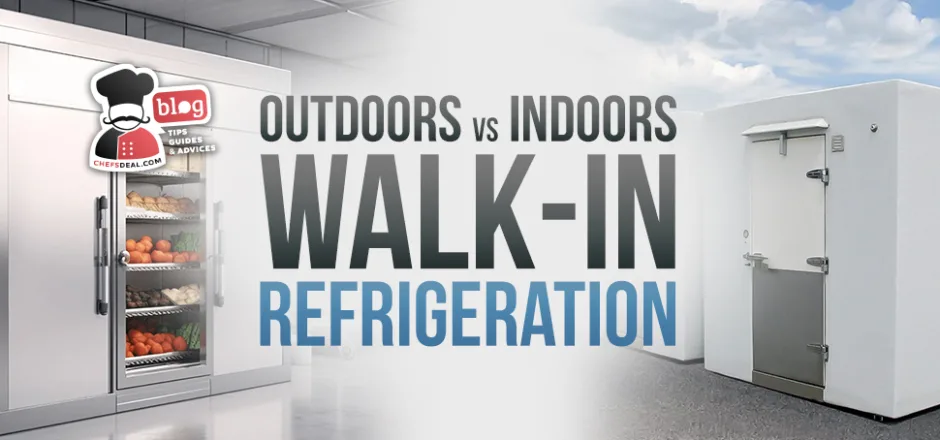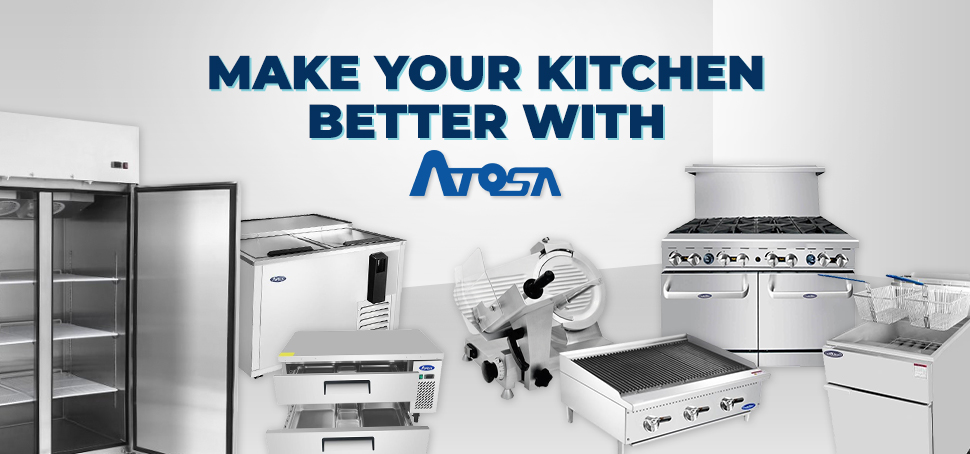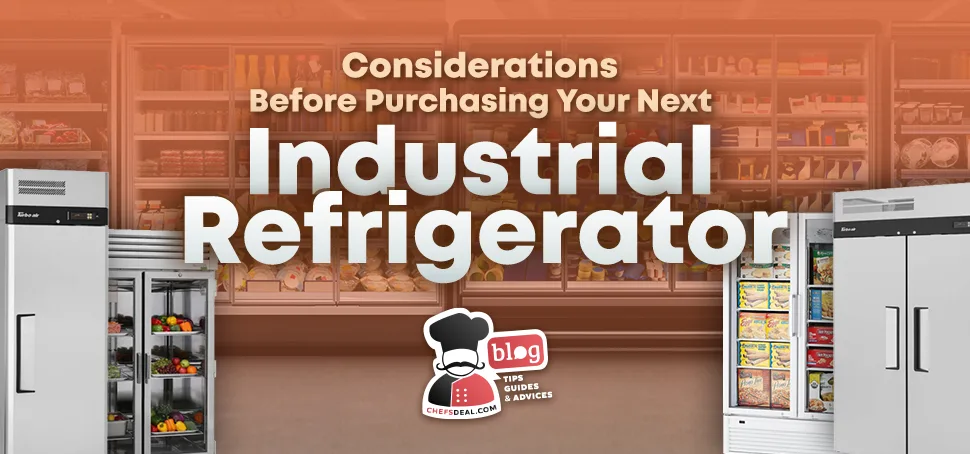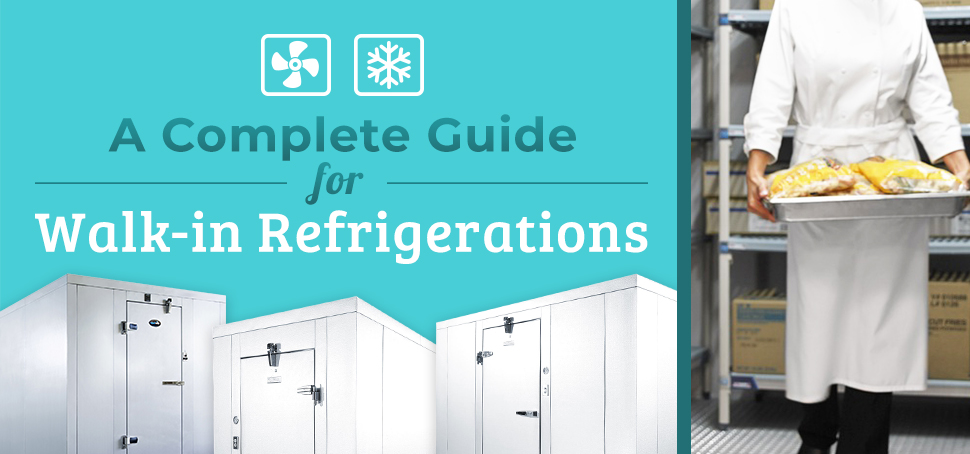Outdoor and Indoor walk-in refrigeration are the two main location categories you need to choose from when buying a new unit. Each has unique advantages and disadvantages depending on your space, geographical location, business layout, accessibility requirements, and budget.
Before you make a purchase, you should know the compliance and safety considerations, relevant technological advancement, energy efficiency and operational cost, noise level, code requirement, security and accessibility needs, and overall price differences between indoor and outdoor walk-in refrigerators and freezers. For instance, outdoor units are the better choice in colder climates with relatively less harsh conditions, whereas indoor units are better for places with extreme heat or harsh weather occurrences. Similarly, if you have so limited space indoors that you can’t leave the mandatory 2-4″ (5.08-10.16 cm) clearance off the walls, you should consider an outdoor unit to abide by federal and local codes.
Making an informed decision and choosing the right model will benefit your business tremendously by reducing costs, maximizing efficiency, and using your space wisely. Read our blog to endow your business with the right choice!
Outdoor Walk-In Refrigeration
Outdoor walk-in coolers and freezers are situated outside your kitchen to free up space indoors and are characterized by robust design and heightened security measures above all. Many establishments, ranging from big hotel kitchens to florists and restaurants, use outdoor walk-in coolers and freezers to maximize the efficiency of space usage indoors while utilizing their available outdoor land. They are used to store perishable goods such as food ingredients, flowers, medicines, and more. A walk-in cooler typically maintains temperatures ranging from 35°F to 45°F (1.7°C to 7.2°C), whereas a walk-in freezer is typically programmed to operate within the temperature range of -10°F to 0°F (-23°C to -18°C).
Outdoor coolers and freezers have thicker and more robust insulation panels to reduce the climate impact. They withstand summer temperatures or snowy weather to efficiently serve your business through all seasonal changes. It is best to opt for units with high R-value, at least 25 for coolers and 30 for freezers, if you plan on getting an outdoor unit. Remember that outdoor units always come with floors to prevent heat loss and create a better and safer work environment for your staff.
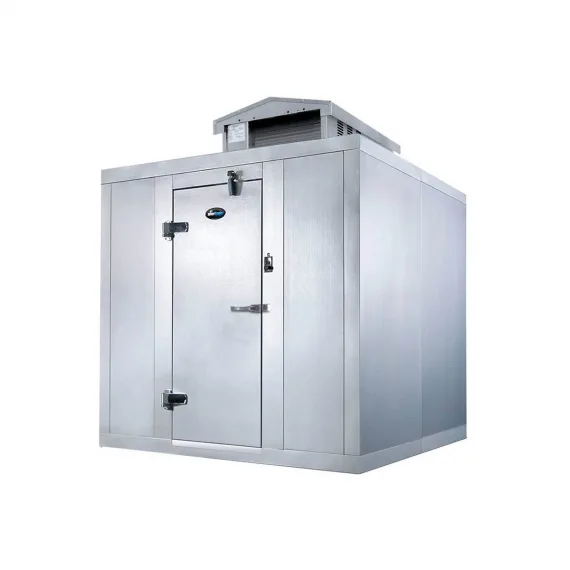
Advantages Outdoor Walk-In Refrigeration
There are 4 advantages to outdoor walk-in refrigeration:
- Efficient Use of Space: Walk-in coolers and freezers are bulky pieces of equipment, and placing them outside of your kitchen can save you a lot of space indoors. By freeing up such a large area, you can ensure a better workflow and make the staff’s job easier.
- Ease of Access for Deliveries: Outdoor walk-in units offer convenient access for loading and unloading goods, especially for businesses with frequent deliveries or large quantities of inventory. You can bypass all the hallways and narrow passageways of an indoor space and establish a direct line between delivery trucks and an outdoor unit, making deliveries faster and more efficient.
- Reduced Noise: Operating the refrigeration unit outdoors helps mitigate noise levels inside the building, creating a quieter environment for employees and customers. Eliminating such a nuisance in the workspace will positively affect staff performance.
- Better Ventilation and Temperature Control: Outdoor units benefit from natural ventilation, which can improve airflow and energy efficiency compared to enclosed indoor spaces. Indoor units heat the kitchen with the air they exude, which can prove quite taxing on your ventilation and air conditioning systems. Outdoor units eliminate this problem entirely.
Disadvantages Outdoor Walk-In Refrigeration
There are 4 main disadvantages of outdoor walk-in refrigeration:
- Exposure to Weather Conditions: Outdoor units are susceptible to weather conditions such as rain, snow, and extreme temperatures, which potentially impact their performance and longevity if not properly maintained or protected. These are serious dangers, but they can be prevented by weatherproofing the unit and opting for high R-value insulation. Accessories and necessary material choices in the production stage drive up maintenance and upfront costs.
- Security Concerns: Being located outside the building leaves the unit vulnerable to vandalism or theft, especially if it houses valuable inventory or equipment. These issues can be circumvented with additional security measures such as alarms, digital monitoring systems, and hiring security staff, keeping in mind that these will cost you extra.
- Site Preparations: Installing an outdoor walk-in unit requires thorough site preparation. The allocated area can’t be an ordinary slab of asphalt. You will need to weatherproof, ensure proper drainage, and establish a route from the kitchen to the unit. Such considerations can spike up installation costs and complicate the process.
- Access Limitations: While an outdoor unit is very convenient for the delivery staff, it can be challenging for the kitchen staff. The distance between the food prep area and the storage area and the accessibility of the route play crucial roles in the efficiency of staff performance and overall workflow. Such units can’t be accessed at a moment’s notice, which proves tiresome in fast-paced kitchens with minimal internal storage space.
Indoor Walk-In Refrigeration
Indoor walk-in coolers and freezers are storage units located within a building or kitchen. They are designed to store perishable goods at temperatures ranging from 35°F to 45°F (1.7°C to 7.2°C) for coolers and -10°F to 0°F (-23°C to -18°C) for freezers. They are utilized in various sectors, such as hotel kitchens, restaurant kitchens, laboratories, and more. Also, you can buy an indoor model without a floor if your space is suited to shouldering the unit’s weight without risking the insulation.
These units are often preferred for their convenience, as they are easily accessible from within the building, allowing for efficient inventory management and streamlined operations. The contents of the storage space can be easily accessed, removed, and replaced at a moment’s notice with these models. Additionally, indoor walk-in coolers and freezers offer protection from external weather conditions, vandalism, and theft, further enhancing their appeal in commercial settings. Overall, their versatility, accessibility, and reliability make indoor walk-in refrigeration units a valuable asset and a popular option for business owners.
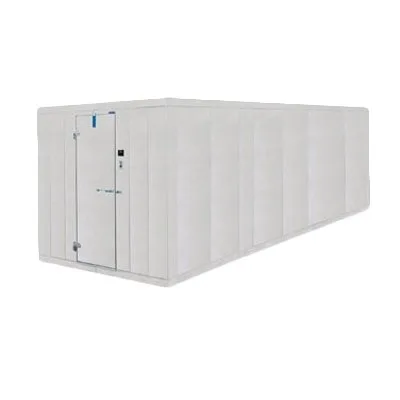
Advantages of Indoor Walk-In Refrigeration
There are 6 main advantages of indoor walk-in refrigeration units:
- Minimum Climate Impact: Indoor walk-in refrigeration units benefit from being sheltered within a building. This allows you to control the temperature regardless of external weather conditions and ensure the consistent storage conditions of your goods. Such a benefit is priceless if you live in a region with extreme weather conditions.
- More Secure: Being located within a building provides added security against vandalism, theft, and unauthorized access. While an outdoor unit would need additional security measures, an indoor unit can get by on overall building security measures and only needs basic features such as digital locks and simple alarms.
- Accessibility and Convenience: Indoor walk-in refrigeration units are easily accessible since they are in the kitchen. Staff members can quickly retrieve or store items without the need to venture outdoors, saving time and effort.
- Compliance with Regulations: Indoor walk-in refrigeration units can be integrated seamlessly into building codes and regulatory requirements since they are installed in contact with the HVAC of the building. Ensuring compliance with health and safety standards for walk-in coolers and freezers requires businesses to have proper drainage and ventilation in place, and establishing these separately for an outdoor unit can prove to be a challenge. Instead of dealing with building a separate HVAC system, you can simply rely on the building’s infrastructure with minimal changes.
- Fewer Accessories Needed: Since indoor units are sheltered from weather conditions and are not as vulnerable to theft, additional accessories, such as extra alarms, locks, weatherproofing, gutters, etc., are not necessary. This will save you quite a bit of money in the long run.
- Less Expensive: The upfront cost of an indoor unit is less than the upfront cost of an outdoor unit on average. If you are on a budget, the price difference in terms of the unit itself and its installation expenses can make a huge difference.
Disadvantages Indoor Walk-In Refrigeration
There are 5 main disadvantages of indoor walk-in refrigeration units:
- Bulky Equipment in the Kitchen: Indoor walk-in refrigeration units are bulky pieces of equipment that require a large, dedicated space within the kitchen. The unit’s bulkiness, paired with its special location requirements, such as needing to be situated 6″ (15.24 cm) off the ceiling and 2″-4″ (5.08-10.16 cm) off the walls, can pose challenges for businesses with spatial constraints.
- Installation Complexities: While it is easier to avoid code violations, integrating indoor walk-in refrigeration units into existing buildings can be complex and may require modifications to accommodate ventilation, drainage, and electrical requirements. Retrofitting existing infrastructure systems to accommodate refrigeration units will require an experienced team and may cause a period of downtime for the building and the business.
- Maintenance Accessibility: Most businesses situate their walk-ins in tight spaces or alcoves where regulations are followed only at a minimal level. Accessing such units for routine maintenance or repairs may be more challenging compared to outdoor units since tight or confined spaces are not accommodating to such interferences. You will need to move the unit out of the tight space to facilitate maintenance, which might mean moving around many pieces of equipment in the process and disrupting your kitchen layout. This can lead to delays in servicing, potential disruptions to operations, and even lead you to shut down for a couple of days to carry out maintenance and cleaning.
- Indoor Air Quality Issues: Poorly maintained indoor walk-in refrigeration units contribute to indoor air quality issues, such as mold growth or odors if moisture buildup or leaks occur. Proper ventilation and maintenance are essential to avoid these risks and ensure a healthy work environment. You might face high temperatures due to the hot air from the unit getting trapped in the kitchen if your ventilation is not up to code. Paired with low air quality, it makes working in the kitchen a hell and overburdens your air conditioning system.
- Cracks on the Floors: Walk-in units are very heavy pieces of machinery. You need to get your floors checked to see if they can shoulder the weight of the cooler or the freezer. If your floors aren’t sturdy enough, you might see cracks over time on the surface, which can compromise the insulation of the walk-in.
- Noise: It might make a lot of noise in the kitchen if the unit doesn’t have a remote condenser. The constant hum of the machinery in the background can lower staff performance and make your workspace less comfortable in general.
Comparison: Outdoors vs. Indoors
You can refer to the table below to compare outdoor and indoor units based on metrics that are most valuable to you and see which one is better in terms of these specifications:\
Features | Indoor | Outdoor |
| Cost | + | |
| Space Needs | + | |
| Exposure to Climate | + | |
| Safety | + | |
| Maintenance Implications | + | |
| Noise | + | |
| Accessibility for Staff | + | |
| Accessibility for Deliveries | + |
What are Compliance and Safety Considerations for Outdoor and Indoor Walk-ins?
Placement of the unit in relation to its surroundings, its incorporation into the HVAC system, and similar are among the compliance and safety considerations for outdoor and indoor walk-ins. While some codes and requirements apply to both, there are unique applications based on the unit’s location. Here are 5 compliance and safety considerations for walk-in units:
- Ventilation: Place indoor walk-in refrigerators and freezers 6″ (15.24 cm) away from the ceiling and 2″ (5.08 cm) from the walls to allow airflow.
- Security: To protect your outdoor unit from theft, purchase additional security measures, such as security cameras, digital locks, and the like.
- Safety Releases: Equip all units, regardless of their location, with a working safety release mechanism to prevent entrapment.
- Ensure the Door is not Blocked: Indoor units might have trouble opening doors if the space is too tight. Ensure that nothing obstructs the doors. Consider sliding doors if swinging doors or an outdoor unit are not an option.
- Placement of the Unit in Relation to Other Equipment: Walk-in coolers and freezers should be placed away from any machinery giving off heat and grease, such as ovens or stoves. It will have a poor impact on both and make it harder for the walk-in to cool down and maintain low temperatures if such machines are placed next to each other.
What are The Technological Advancements That Affect The Choice of Location for Walk-in Refrigeration?
Technological advancements such as remote condensers and remote monitoring systems have reduced the implications of certain disadvantages related to having an indoor or outdoor refrigeration unit. Thanks to these advancements, you can ease your concerns and compensate for the shortcomings of your intended unit.
- Remote Monitoring and Control Systems: Remote monitoring systems allow operators to track temperature, humidity, and other environmental factors in real-time from anywhere with internet access. Thanks to this addition to your unit, you can use your outdoor walk-in with more ease and minimize the climate’s impact on its performance by taking timely measures. Such an advancement greatly reduces the chances of theft and vandalism.
- Adaptive Climate Control Systems: Some walk-in refrigeration units feature adaptive climate control systems that can adjust cooling capacity based on external factors such as ambient temperature and humidity. This feature partially eliminates an outdoor unit’s biggest shortcomings by resisting fluctuating environmental conditions and temperatures.
- Predictive Maintenance Based on Data Technologies: Digital data processing systems monitor your walk-in’s performance data and predict potential failures. If you have no choice but to place your unit in a tight and hardly accessible space, this advancement helps prevent unexpected breakdowns and downtime and optimize your maintenance schedule.
- Building Management Systems (BMS): BMS is a software that allows businesses to oversee and manage the entire building’s operation systems and functions from one place. The system collects data and offers information about how to manage your energy and more in the most optimal way possible. Indoor walk-in refrigeration units are a big addition to an establishment’s infrastructure. Thanks to this advancement, you can leverage existing infrastructure and maximize operational efficiency while ensuring the unit doesn’t overburden the system.
FAQs About Outdoor and Indoor Walk-in Refrigeration
Here are 12 FAQs about outdoor and indoor walk-in refrigeration
What are the energy efficiency differences between outdoor and indoor walk-in refrigeration?
On average, indoor units are more energy-efficient than outdoor units since outdoor units need to achieve and maintain the target temperature under fluctuating weather conditions. However, energy efficiency highly depends on the brand, model, technological features, R-value, and insulation thickness, so it cannot be necessarily or solely reduced to the location of the walk-in.
Are outdoor refrigerations generally cheaper than indoor refrigeration?
No, outdoor units are not generally cheaper than indoor refrigeration. Outdoor walk-ins need to be made of more robust material and equipped with weatherproofing and floors. All these drive the price up, and outdoor walk-in coolers and freezers are often pricier than indoor models.
Which placement is more energy-efficient?
In general, indoor walk-in placement is more energy-efficient since the unit will suffer less from external climate and weather conditions.
Is it more expensive to maintain an outdoor refrigerator?
Yes, it can be more expensive to maintain an outdoor refrigerator. Due to its exposure to potentially harsh weather conditions and vulnerability to vandalism, outdoor units could require more frequent maintenance to get rid of cosmetic issues or damaged components.
Is outdoor refrigeration noisier than indoor refrigeration?
Outdoor refrigeration is not necessarily noisier or quieter than indoor refrigeration. While having the unit outside reduced the noise within the kitchen, the noise levels of a walk-in aren’t defined by its location. The compressor generates most of the noise, and you can eliminate most of the noise in both units by investing in a remote compressor, installing noise-reducing features, or soundproofing around the walk-in.
Does placement affect the lifespan of the walk-in refrigeration unit?
Placement affects the lifespan of the walk-in refrigeration, but it is not the main or sole defining factor. Outdoor walk-in coolers and freezers face more challenges than their indoor counterparts, which may reduce their lifespan slightly. The lifespan of a unit hinges on its material quality, maintenance, and care over the years and whether it was used properly and within limits. If all was well and the outdoor unit was designed to perform in an outdoor space, the lifespan of the units wouldn’t differ much based on their location.
What are the most common code requirements for walk-in Refrigeration placement in my area?
To find out the code requirements for walk-in refrigeration placement in your area, you should research local codes and requirements on your relevant state website. The code requirements for walk-ins that you should look listed below:
- Energy Efficiency
- Installation and Maintenance
- ADA Standards
- Food Safety Standards Set by organizations like the FDA
- Refrigerant Safety Compliance with the International Fire Code, ASHRAE 15, and IIAR standards
- Ventilation Requirements
- Environmental Regulations
- Staff Training
- Cleaning and Sanitization
- Emergency Procedures
- Record-keeping
What steps should I take to protect the refrigeration from harsh weather?
To protect walk-in refrigeration from harsh weather, choose a sheltered location, install weatherproof enclosures, and ensure proper insulation and sealing. Implement drainage systems, elevate foundations, and perform regular maintenance to prevent damage from rain, snow, and wind. Monitor weather conditions and take emergency precautions when necessary to safeguard the refrigeration unit.
Can I use an outdoor Refrigeration in cold climates?
Yes, outdoor refrigeration units can be used in cold climates with proper insulation, anti-frost measures, and snow clearance to maintain efficiency and prevent damage from freezing temperatures. Additional protection from wind and weather may be necessary to ensure stable operation during extreme conditions.
How can I ensure easy access to outdoor walk-in refrigeration in all weather conditions?
You can ensure easy access to the refrigeration unit in all weather conditions by choosing a well-protected location and maintaining a clear pathway free from snow, ice, and debris. Installing weatherproof enclosures, adequate lighting, and non-slip surfaces can ease your job significantly. You should conduct regular maintenance to ensure all measures are in top condition.
What security measures are recommended for outdoor walk-in refrigeration?
Installing secure locks or access control systems to prevent unauthorized entry, implementing surveillance cameras or motion sensors to prevent theft, and ensuring proper lighting around the unit to enhance visibility are among the recommended security measures for outdoor refrigeration. Hiring security staff is an option to keep the inventory safe and to prevent possible damages.
To ensure the outdoor walk-in refrigeration is in good condition and operating efficiently, insulation and weatherproofing, sun protection, moisture protection, regular maintenance, and pest control are helpful measures.
How will the heat generated by the walk-in refrigeration impact my indoor temperature?
The heat generated by a walk-in refrigeration unit impacts indoor temperatures depending on factors such as the size of the unit, insulation of surrounding walls, and ventilation in the indoor space. In general, the heat released from the refrigeration unit’s condenser coils and compressor contributes to an increase in indoor temperature, especially in smaller or poorly ventilated spaces. However, regular maintenance of fans and condenser coils, proper insulation and ventilation measures help lower the impact of heat transfer from the refrigeration unit to the indoor environment, ensuring more stable indoor temperatures.
Conclusion for Outdoor vs. Indoor Walk-in Refrigeration
In conclusion, when deciding between outdoor and indoor walk-in refrigeration units, it’s crucial to consider various factors such as space constraints, climate conditions, compliance and safety requirements, and financial concerns.
Outdoor units offer benefits like efficient space utilization, reduced noise, and improved ventilation. They require weatherproofing and security measures to withstand outdoor elements. Indoor units provide accessibility, security, and compliance advantages but require careful planning for installation and maintenance within existing structures.
Technological advancements, such as remote monitoring and adaptive climate control systems, help reduce the impact of some disadvantages associated with both types of units. Ultimately, making an informed decision based on your specific needs and circumstances will optimize efficiency, reduce costs, and ensure the longevity of your walk-in refrigeration investment.

